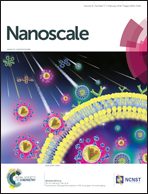Can antimonide-based nanowires form wurtzite crystal structure?†
Abstract
The epitaxial growth of antimonide-based nanowires has become an attractive subject due to their interesting properties required for various applications such as long-wavelength IR detectors. The studies conducted on antimonide-based nanowires indicate that they preferentially crystallize in the zinc blende (ZB) crystal structure rather than wurtzite (WZ), which is common in other III–V nanowire materials. Also, with the addition of small amounts of antimony to arsenide- and phosphide-based nanowires grown under conditions otherwise leading to WZ structure, the crystal structure of the resulting ternary nanowires favors the ZB phase. Therefore, the formation of antimonide-based nanowires with the WZ phase presents fundamental challenges and is yet to be explored, but is particularly interesting for understanding the nanowire crystal phase in general. In this study, we examine the formation of Au-seeded InSb and GaSb nanowires under various growth conditions using metalorganic vapor phase epitaxy. We address the possibility of forming other phases than ZB such as WZ and 4H in binary nanowires and demonstrate the controlled formation of WZ InSb nanowires. We further discuss the fundamental aspects of WZ growth in Au-seeded antimonide-based nanowires.


 Please wait while we load your content...
Please wait while we load your content...